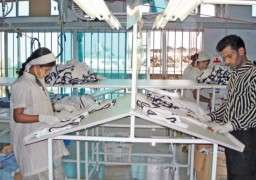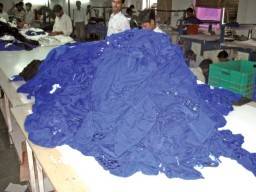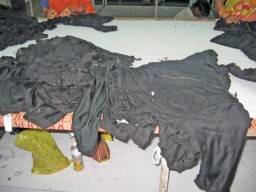
Garment producers are working hard under stressful circumstances to make a satisfactory level of profitability. They are extremely worried maintaining their competitive edge as lead times are becoming increasingly short; late deliveries are resulting in heavy penalties, and buyers are asking for more discounts and demanding dispatch by air leading to annihilation of profits. Roger Thomas of Methods Apparel Consultancy investigates…
Typically finishing involves post sewing operations like ironing / packing, however there are also several non value operation such as inspection and corrective operations like thread trimmings & spotting. The common practice with most factories is to produce garments, examine them, than iron them, again examine them and send them to washing but without removing the thread.
At times the garments are examined up to five times, the threads are cut twice and the pressing is done twice. In all, the garments pass through 13 processes before completion.
The duplication of the processes is shocking and it is because no one wants to take responsibility for their actions, different processes are just duplicated in order to eliminate as many problems as possible. This is all very well but considering the costs involved and the shipment delays caused, one will obviously come to the conclusion that the process needs to be critically examined and reworked to find a better solution.
The investigations conducted in 10 such factories in the NCR-Delhi reflected the same trends and revealed worrying information.
1. The time taken to finish a garment varied from 57.6 minutes to 11.2 minutes;
2. Departmental layout is generally poor;
3. Alteration rates can be as high as 30 to 40%;
4. Spotting seems to be necessary on nearly all of the garments and the emphasis is in removing the spots rather than the cause of them;
5. Workplaces are poorly planned if at all, generally there are long tables where all of the work is performed;
6. There are no monitoring systems to establish the performance levels of the workers;
7. The emphasis is on getting the garments ready for dispatch, there is no attempt to investigate how this is being done.


What should we do to improve?
Thread Trimming on the Line With each successive sewing operation the amount of uncut thread increases and the remaining threads from previously sewn operations are caught in the next seams which can cause major time losses and quality problems in future operations. It is important to make every operator clean their own threads on the completion of their operation and for doing so, each operator should be provided with a thread clipper so that the uncut threads are trimmed at their origin itself. But in an established factory this is difficult to do as it is considered a poor alternative (Photo 1).
Operators who trim the threads should be trained to work methodically to a set pattern so that each garment is handled in exactly the same way, starting at the same point and progressing around the garment in a pre-determined sequence to ensure that every part of the garment is processed prior to its completion.
Special wire top workplaces are also recommend for thread cutting which allows removed threads to fall into a trough built into the table so that they do not land on the next garment to be trimmed, a bag is fixed to the bottom so that the thread are collected and not deposited on the floor (Photo 2).
At times it is difficult to ensure that threads are removed at the sewing of the operation, particularly in an existing factory but all new sewing trainees must be taught to remove the threads on the completion of their operation, and if UBT (Underbed Thread Trimmer) machines are being used, than see to it that the thread trimmers are working properly and only leave the minimum thread.
Garment Examination
How many companies actually show the examiners or checkers how to check a garment, where to start, in which direction to go, important points to look for, and so on? Practically none.
Even if one were to check how examiners work and what standard methods he uses, it will be found that a great deal of variance is found as each person is doing his own thing. A properly designed workplace for garment examination and the examination process at the end of sewing line goes a long way to improve product and also monitor productivity of each individual, it is also essential that a complete record of alterations is maintained so that management information is being produced regarding current repair rates.
Washing
“Wash Load”, understood as a collection of completed bundles having a sufficient weight matching the washing machine capacity, comes into picture only when garments are completed from the final check point of the sewing line. Once a sufficient load for washing has accumulated, the tickets from all the bundles are removed and kept aside. When the required “Wash Load” has been created, the tickets are given to the operator at the ironing station who replaces them and reconstitutes the bundles. This process not only eliminated the ‘sorting’ operation but also helps control operator performance.
[bleft] The duplication of the processes is shocking because no one wants to take responsibility for their actions, so we just duplicate them to try to eliminate as many problems as possible. But considering the costs involved and the shipment delays caused, one can conclude that the process needs to be critically examined and reworked. [/bleft]
Ironing
What is the use of pressing the garments before thread cutting and initial checking? This is one complete non-value adding operation which can be easily removed. The garments finish in almost the same condition as they were before the process was done, so the whole process is a waste of time and labour.
Obviously garments have to be pressed or steamed after washing so that the other finishing processes can be completed but the garments should go for ironing only once, and that is before final checking (Photos 3&4).
To eliminate creasing after ironing, the garments should be hung and continue to be worked on from a hanger. This will remove the final pressing process before bagging. Garments can have the odd thread removed on the hanger whilst doing the final check. The measurements should also be confirmed at this time. This process flow serves to eliminate duplication of operations and will dramatically reduce handling of the garments, if they require no alterations they can proceed further. A process to ensure that all alterations are dealt with immediately is essential. This process flow will reduce at least five operations from the traditional sequence.
Spotting
The question should be asked – Why are there so many dirty marks on the garment in the first place? Many companies have multiple spot removing guns, using very expensive chemical and use it like water. Why do they not investigate the reasons for the soiled garments, surprises all?
It is possible to keep garments clean while working in such grimy conditions (Photos 5&6). It is important to review how garments are handled after the washing process has taken place. It must also be made sure that all surfaces, tables, transport media and walls, etc. are kept in a clean condition; obviously most of the dirty marks come from the workplaces and one of the key reason is that the workers did not wash their hands.
Training
Training and retraining is the key to the success of any organization. It begins with imparting a basic knowledge of garments including a basic understanding of pattern and garment terminology, part recognition, garment zone classification, types of defects, measuring points of basic garments, hygiene and cleanliness, the introduction to concept of cost of quality, and then it gradually proceeds to the actual methodology involved to ensure that the total garment is acceptable.
Given here is an example of few measuring points in Polo neck T-Shirt (Diagram 1):
It is important to develop a sense of responsibility/accountability in the operators for their respective operations. It is obvious that if the work examined is going to be checked by someone else then it is not he who is responsible for missing errors, but the responsibility lies on person who checks his work. It is important to check the garments at the rate prescribed by the trainers or superiors; if he misses anything the next person up the line will find it. So, in addition to the know-how’s, operators should also be taught the know-why’s.
Proposed Flow
A process flow is good if it controls and optimizes throughtput time and reduces WIP (Diagram 2). In the very start itself, add thread cutting to the sewing lines and ensure that all threads are removed at this point. Work remains in bundles throughout the sewing thread cutting and examination stage or check points. Any alterations done at this point must be put back in the original bundle form (This will ensure accurate monitoring of production) before it becomes part of the “wash load”.
The “wash load” on its return from the washing department, gets ironed, put onto a hanger in bundle form and then proceeded through the processes without being removed from the hanger until the folding station (Diagram 3). The processes are to be done in bundles; bundles be made complete throughout, tickets be taken out by the operators doing the operations and their productivity monitored using the correct data collection forms. Repairs at all stages should be monitored again and a quality performance figure established.
The question to be raised of course is, “Why do we have a separate finishing area?” These processes could be done as an extension to the sewing line, why do they need to be done in a separate section?
Lots to think about in our constant search for the best way forward! And do we see the potential to save costs and improve throughput time?

Post a Comment